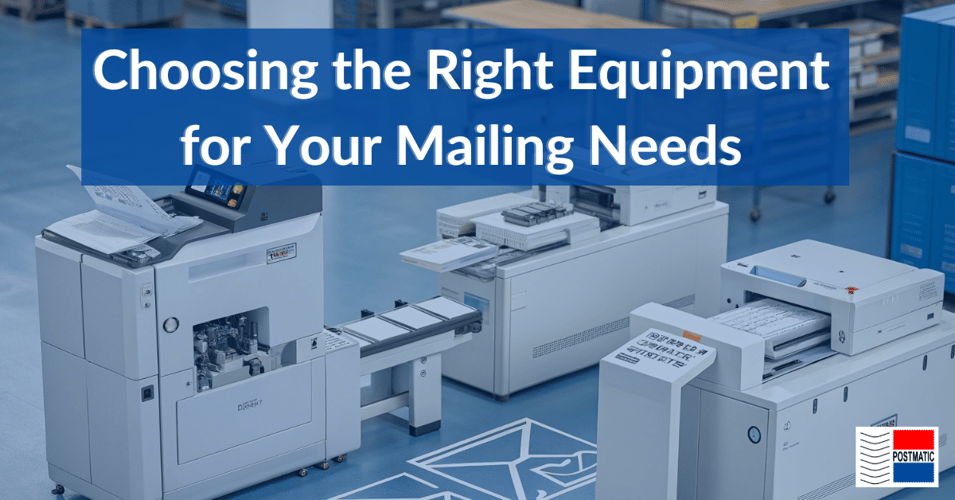Choosing the Right Equipment for Your Mailing Needs

Table of Contents
Researching the right mailing equipment is a crucial step in ensuring your business operates efficiently and stays cost-effective. Choosing the Right Equipment for Your Mailing Needs requires careful evaluation of your unique requirements to streamline operations, reduce errors, and improve overall productivity. The right tools can help you save time, minimize costs, and ensure a smoother workflow. Below, we’ll break down the key factors to consider when making this important decision.
Assessing Your Mailing Requirements
Successful decision-making begins with understanding the specific needs of your business. To decide on the right equipment, you must first evaluate your mailing requirements, including the type, volume, and frequency of mail your organization processes.
- Mail Volume and Frequency: Determine how much mail your business sends on a daily, weekly, or monthly basis. For example, a small business sending out occasional invoices may need less sophisticated machinery compared to a large organization handling bulk mail regularly.
- Mail Types: Consider whether your mail primarily consists of letters, flat envelopes, or bulky packages. Different equipment caters to specific formats based on size and content.
- Operational Scale: Identify the scale of your operations—is your need more general, or do you require specialized solutions? For instance, companies managing marketing campaigns may need equipment with advanced automation and tracking capabilities.
A practical approach is to create a checklist of requirements. For example, list your average mail volume, the variety of mail sizes you deal with, and any preferences for automation. This preparation will guide you in selecting a machine that aligns with your operational demands.
Maintaining a clear view of your mailing needs ensures you invest in equipment that provides the best value for your business.
Key Features to Look For
Once your requirements are defined, focus on the essential features that make mailing equipment functional and efficient. Prioritizing key characteristics ensures your investment pays off in the long term.
- Durability and Longevity: Mailing equipment should endure frequent use. Look for machines crafted with robust materials that offer long-term reliability.
- Automation Features: Automation is an asset. Seek equipment equipped with features like envelope feeders, friction feed mechanisms, and auto-tray stacking.
- Ease of Integration: Many businesses already use mailing systems or software for tracking purposes. Ensure new equipment integrates seamlessly with your existing systems.
- Efficiency Enhancements: Innovations like precision rollers or advanced sorting capabilities enhance workflows, reducing time spent on repetitive tasks.
For instance, a large organization can benefit from automated systems that reduce manual sorting and preparation, while cost-efficient systems focused on smaller-scale operations are ideal for startups.
A tip: When assessing equipment, request demos or hands-on trials. This allows you to see how features perform in real time and judge whether they meet your expectations.
Balancing Cost and Performance
Striking the right balance between cost and performance is one of the toughest yet most essential considerations when purchasing mailing equipment. While the allure of low-cost options exists, cutting corners may lead to limitations that hinder efficiency.
- Total Cost of Ownership (TCO): Evaluate not just the upfront price but the lifetime savings or expenses the machine may yield. Include factors such as maintenance and repair costs, downtime impacts, and consumables like ink and labels.
- Cost-Saving Benefits of Quality: Investing in high-end equipment might seem costly initially, but its durability and performance can justify the price over time. For example, an automated sorter may involve a higher upfront budget but eliminate the need for additional labor or outsourcing to process bulk mail.
Imagine a business choosing between two envelope sealers. A budget option might seem adequate short term, but a premium machine offers faster speeds and lower error rates, leading to savings down the road.
A takeaway from this: analyze your budget alongside performance metrics to find equipment that’s both practical and cost-efficient. This balance ensures your mailing operations remain productive without straining resources.
Top Tips for Making the Right Choice
With a multitude of options available, selecting one can feel overwhelming. Following these tips can simplify the decision-making process:
- Compare brands and models: Research reputable brands and focus on equipment suited to your specific needs. Use comparison charts to narrow down options.
- Read customer reviews: Reviews can offer insights into real-world performance and reliability to avoid any hidden pitfalls.
- Test before you buy: Request demonstrations where possible. Hands-on interaction allows you to gauge usability and build confidence in your choice.
- Vendor support services: Select vendors that offer robust support systems, including professional installation, employee training, and ongoing maintenance packages.
- Consult experts: When in doubt, reach out to industry experts or seek recommendations from businesses similar to yours.
By applying these tips, you can cut through the noise and make informed purchasing decisions with confidence.
Investing in the right mailing equipment is essential to maintaining operational efficiency, accuracy, and cost-effectiveness. By thoroughly evaluating your needs, understanding key system features, and balancing cost with performance, your organization can achieve long-term success. Don’t leave critical decisions to chance.
For expert guidance and tailored recommendations, contact our team at Postmatic or email us directly. We’re here to support your mailing operations with industry-leading solutions.






